Fujifilm Finepix HS20 EXR Review
Fujifilm Finepix HS20 EXR Introduction
The Fuji Finepix HS20 EXR is an SLR-styled ultra-zoom with one of the most versatile zoom ranges. Its 30X optical zoom lens has an amazing 24-720mm equivalent range, starting ultra-wide and reaching beyond most super-telephoto lenses. The lens is mechanically-linked for smooth, quick and precise control. Like most ultra-zooms of a similar form-factor, the HS20 EXR has a complete of manual controls.
Like its predecessor, this digital camera is based on a BSI-CMOS sensor that has been upgraded to 16 megapixels and enhanced with Fuji's unique EXR technology. This lets it keep high-speed features while allowing triple-mode operation to capture high-resolution, high dynamic-range or low noise images.
Externally, the HS20 EXR looks exactly like the HS10. Internally, it uses the same sensor as the much smaller F550 EXR. Being the new Fuji flagship, the HS20 is very feature rich and includes all the features of the F550 EXR except for the built-in GPS. Compared to the HS10, a few high-speed features where slightly downgraded, most likely to keep up with a sensor that outputs 60% more pixels. Most notably the top speed at full-resolution is now 8 FPS instead of 10 FPS and the top video recording speed if 320 FPS down from 1000 FPS.
Headline Features of the Fuji Finepix HS20 EXR
- 16 Megapixels EXR CMOS sensor
- ISO Range from 100 to 3200 at 16 MP
- ISO 6400 at 8 MP and ISO 12800 at 4 MP
- Auto or Set Dynamic Range up to 400% at 16 MP
- HD Video Recording at 1920x1080 @ 30 FPS
- High-speed Video from 80 to 320 FPS
- 8 FPS Continuous Drive at 16 MP, 8 JPEG / 6 RAW
- 11 FPS Continuous Drive at 8 MP, 16 JPEG
- 1/4000-30s Shutter-Speed, Plus Bulb
- Full Manual Controls
- Multi-Segment, Center-Weighed & Spot Metering
- AEB Bracketing, 3 frames, 1/3-1 EV stops
- Auto, Preset and Custom White-Balance
- White-Balance Fine-Tuning, 2-axis, 7-steps
- Provia, Velvia, Astia, B&W, Sepia Film Simulation
- 360-Degree Panorama Sweep
- Multi-Frame Pro Low-Light & Pro Focus Modes
- 30X Ultra-Wide Angle Mechanical Optical Zoom
- Built-In Image Stabilization
- 1-Axis Digital Level
- Hot-Shoe for External Flashes
- Tiltable 3" LCD 460K Pixels
- 0.2" EVF 200K Pixels
- Eye-Start Sensor
- Powered by 4 AA Batteries
- SXDC Memory Cards
Resolution Priority (EXR-HR)
- 16 Megapixels
- ISO 100-800
- Auto ISO up to 800
- Fixed 100% Dynamic range
- 4s Min Shutter-Speed
Dynamic-Range Priority (EXR-DR)
- 8 Megapixels, Two-Stage Read-Out
- Auto ISO up to 3200
- Selectable 100% to 1600% Dynamic Range
- Automatic Dynamic Range up to 1600%
- 4s Min Shutter-Speed
Low-Noise Priority (EXR-SN)
- 8 Megapixels, Binned Read-Out
- ISO 100-1600
- Auto ISO up to 3200
- Fixed 100% Dynamic Range
- 4s Min Shutter-Sped
Auto EXR
- Automatic Resolution, Fixed 8 MP or Fixed 4 MP
- Full-Time AF-C Only
- Auto ISO Only
- Auto Dynamic Range Only
- Auto Exposure without Compensation
- Multi-Segment Metering Only
- 1/4s Min Shutter-Speed
Fujifilm Finepix HS20 EXR Suitability - What is it good for?
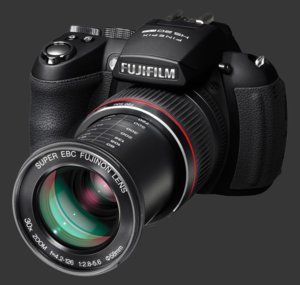
The Fuji Finepix HS20 EXR is defined by its unique lens. The huge range with built-in stabilization allows it to cover a range of photographic subjects like no other. Ultra-wide is perfect for architecture, landscapes, indoor shots and monuments. At the other extreme, a reach of 720mm makes it suitable for wildlife and even birding. To reach a similar range on a DSLR would require the use of a lens weighing several kilos and costing thousands of dollars. Needless to say, all other photo applications are covered: portraits, street photography, sports and more.
The mechanical-link allows smooth and quick framing of subjects. Notice that we did not say precise because the HS20 EXR suffers from a slightly cropped view-finder, so framing is not so exact. Having no zoom motor not only saves energy, it also produces completely silent zooming while filming video.
The Fuji Finepix HS20 EXR digital camera is designed for efficient access to its manual controls and offers a large number of buttons to directly control the camera without using the menu. This kind of efficiency that makes it usable in a hurry.
High-speed features such as 8 FPS drive mode and pre-capture makes it more usable that similar cameras for action. The low-light side of things is covered by its 100 to 3200 full-resolution ISO range which is suitable for most uses. At the extreme of low-light, the HS20 EXR stops being usable before its peers due to a slowest shutter-speed that is reduced by one stop for each ISO. At ISO 100, the HS20 EXR can take 30s exposures, at ISO 200 it gets reduced to 15s, by ISO 3200 the limit is a paltry 1s. We suspect this is the case because the noise-characteristics of the CMOS sensor would ruin images otherwise. While there is a Bulb mode, it offers exactly the same limit as manual exposure.
Pictures from the HS20 EXR can be printed nicely in sizes up to 20 "x15" thanks to 16 megapixels of resolution. Near the wide-angle end, the camera can focus as close as 1 cm using super-macro mode. The digital camera also allows control over the dynamic range it captures. Possible options go from 100% to 1600%, although these are not available at all modes and ISO settings. Increased dynamic-range may also reduce image quality in shadow areas.
Both storage and power use the most convenient and readily available formats: SDXC for memory and most types of AA batteries for power. The power meter can be tuned to a specific type of battery and the HS20 EXR can rejuvenate rechargeable batteries.
Fujifilm Finepix HS20 EXR Capability - What can it do?
Beyond taking pictures in a large variety of conditions, it packs some useful and interesting features. Below is a list of its most useful features, followed by explanations, when required.
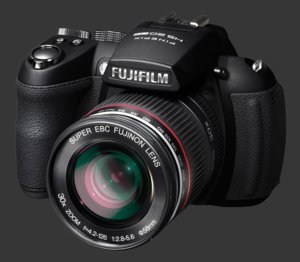
- Dynamic-Range: 100%-400% at 16 MP, 100%-1600% in EXR-DR mode at 8 MP
- White-Balance: Auto, 6 preset and custom, all fine-tunable in 7 steps on Red-Cyan and Blue-Yellow axis
- Metering: Multi-Segment, Spot and Average
- Focus Control: Single Autofocus (AF-S), Continuous Autofocus (AF-C), Manual Focus (MF)
- Autofocus Modes: Center, Multi-pointCamera chooses a point to focus on, AreaUser selects an area to focus on or Tracking
- Drive Modes: Single, First 8 Frames, Best-Frame, AEB, Dynamic-Range Bracket, Film-Simulation Bracket
- Self-Timers: 2s, 10s, Face-Detect
- PASM Exposure Modes
- Exposure compensation: +2 to -2 EV, in 1/3 EV increments
- Flash compensation: -2/3..+2/3, in 1/3 EV increments
- Exposure Bracket: 3 shots, 1/3, 2/3 or 1 EV increments
- Flash Modes: Auto, On, Off, Slow-Sync
- Face Detection: With or without redeye removal, optional face-recognition
- Sweeping panorama, 120°, 240° or 360°
- Pro Low-Light Mode, Multi-Frame Noise-Reduction
- Adjustable Color, Tone, Sharpness, Noise-Reduction, 3-steps each
- AE-L: Toggle or Hold
The Fuji Finepix HS20 EXR offers two methods of dynamic range expansion:
One method is called Highlight Correction and is available at all resolutions. The magic happens using the camera's processor to adjust the tone curve while actually exposing at a lower sensitivity. The consequence is that only a normal dynamic range is obtainable at ISO 100. One can boost the DR to 200% at ISO 200 and up to 400% DR can be captured at higher sensitivities. This gives two more stops of highlight headroom.
The other method, Dynamic-Range Priority (EXR-DR), is unique to EXR sensors and is available at half-resolution (8 MP). In this mode, the sensor uses pairs of adjacent pixels of the same color - which is possible by a special arrangements of the color-filer array - to form a single output pixel by reading one photosite partway during the exposure. This lets photosites be read before they saturate. This is clever trick needs a constant flow of light during exposure and therefore would not work with flash. With this approach the HS20 EXR can capture up to 1600% dynamic range, although we suspect it actually does Highlight Correction too to reach 1600%.
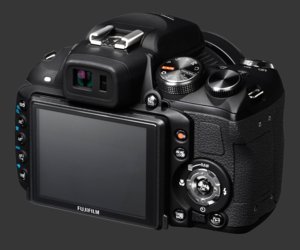
Color is controllable using Film Simulation and traditional Color (Saturation), Tone (Contrast) and Sharpness parameters. There are only 3 steps on each scale, so flexibility is limited. Film Simulation lets the photographer choose between five traditional film looks: Provia, Velvia, Astia, B&W and Sepia. The most natural results are obtained from Provia with Velvia and Astia giving over-saturated and under-saturated results, respectively. White-balance is very flexible. These is an automatic setting, 6 presets and a custom option. All these settings can be fine-tuned along 2 axis in 7 steps.
Best-frame-capture is a sophisticated mode to capture an ideal frame from continuous action. It starts working as soon as the shutter is pressed halfway, continuously capturing images of which only a few are stored, then adding more images after the shutter is fully pressed. The speed at which it does this is controllable between 3 and 8 FPS at 16 MP or up to 11 FPS @ 8 MP. The number of before and after frames is selectable, as long as the total is 8 images at 16 MP or 16 at 8 MP. So one can get 5 images before, 1 image during and 2 image after or 3 images before, 1 during and43 after, or any other combination which adds up to 8. There is a small but noticeable lag in this drive mode but it is clearly better than with most fixed-lens cameras. At least the display keeps up reasonably.
The 20 scene modes are divided into a set of 17 and a set of 2 and Sweep Panorama. Any of the 17 can be accessed by any of the to SP positions on the mode-dial. The next 2 are called Advanced Scene Modes: Pro Low-Light and Pro Focus. Pro Low-Light takes 4 images to combine them into one image with reduced noise. This is similar to what image software call stacking or multi-frame noise-reduction. Pro Focus combines two shots to simulate the background blur associated with fast lenses.
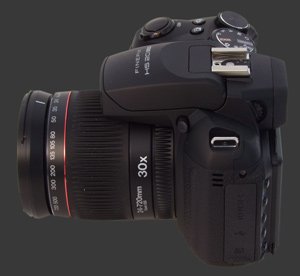
The Sweep Panorama mode is designed to capture a panorama continuously in any direction. The sweep angle can be set to 360°, 180° and 120°. The output is limited to 1080 pixels in landscape orientation and 1624 pixels wide in portrait mode, in the shortest dimension, giving at most an 11520 x 1624 panorama. Fuji greatly improved this mode since its early beginnings and the camera is capable of producing a panorama easily. The output can look impressive from a distance but is often full of stitching errors. Moving elements such as people and vehicles are very problematic. Close by objects also give it great difficulty.
Now, while Sweep Panorama has its issues, most people do not bother properly setting up their camera to manually stitch using a computer later. The trick is to have the patience for a lot of trails and errors. Movement must be done steadily and the camera kept level. If that sounds easy, it is not. At least the HS20 EXR stitches whatever it good up to the point where it could not go on. This means that the panorama may stop before the chosen angle-of-view has been swept. For some reason, it is also possible to do more and sweep around more than 360° which that camera happily stitches anyway. Just below is an example of over a Sweep Panorama spanning more than 360° with a rather good stitch. Note that ISO is always Auto in Sweep Panorama and in low-light it can go up to 3200.

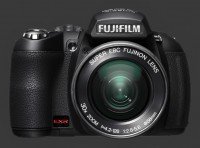 |
Please Support Neocamera
All information on Neocamera is provided free of charge yet running this website is a huge endeavor. Purchases made via affiliate links found throughout the site help keep it running and up-to-date. There is no additional cost to you, so please consider buying via these links to our affilates:
If you found any information on this site valuable and did not purchase via our affiliate links, please considering donating via PayPal:
Any amount will be greatly appreaciated. Thank you for your support!
Fujifilm HS20 EXR Highlights

Sensor-Size: 6 x 5mm

Actual size when viewed at 100 DPI
| 16 Megapixels Ultra Zoom | ISO 100-3200 |
| 30X Mechanically Linked Ultra-Wide Optical Zoom | Shutter 1/4000-30s |
| Built-in Stabilization | Full manual controls, including Manual Focus |
| 0.20" Built-in EVF 200K Pixels | Custom white-balance |
| Automatic Eye-Start sensor | Spot-Metering |
| 1 Axis Digital Level | Hot-Shoe |
| 8 FPS Drive, 8 Images | Standard AA Battery |
| 1920x1080 @ 30 FPS Video Recording | Secure Digital Extended Capacity |
| 3" LCD 460K Pixels |
Updates
2025.01.18

Fujifilm GFX 2025 Lens Roundup
Lens Review roundup of Fujifilm GFX Medium-Format lenses. Quality, performance and handling of the GF20-35mm F/4R WR, GF30mm F/3.5 Tilt-Shift and the GF55mm F/1.7.
2024.11.18

Best 2024 Photography Gifts for Every Budget
Great gifts for photographers and photo enthusiasts selected for every budget among the best products of 2024.
2024.08.07

Eye Protection Tips for Professional Photographers
The four main considerations for professional photographers regarding eyewear.
2024.07.14

Fujifilm X100VI Review
Flagship fixed-lens compact digital camera with a 40 MP sensor and Image-Stabilization, a first for the series. Retro design featuring dual control-dials, plus direct ISO, Shutter-Speed and EC dials. Its hybrid viewfinder can switch between EVF and OVF mode.
2024.05.09

Fujifilm GFX100 II Review
Flagship 102 Megapixels Medium-Format Mirrorless Digital Camera with 8-Stop 5-Axis IBIS, 8 FPS Drive, 8K Video and 400 MP Super-Resolution capture in a weatherproof and freezeproof body with dual control-dials and dual memory-card slots.
2024.04.03

Fujifilm X-T5 Review
Newest Fujifilm flagship boasting a 40 MP APS-C sensor, 5-axis IBIS with 7-stop efficiency, 15 FPS continuous drive, 6.2K Video capture, dual control-dials and dual SDXC UHS-II slots in a sturdy weatherproof and freezeproof body.
2023.11.20

Best Digital Cameras of 2023
Find out which are the Best Digital Cameras of 2023. All the new Mirrorless Digital Cameras from entry-level to high-end professional.
2023.07.10

Fujifilm X-H2 Review
40 Megapixels APS-C Hybrid Mirrorless Digital Camera with 7-stop IBIS. Fastest shutter ever and 8K video capture. Large builtin EVF with 0.8X magnification and 5.8 MP, plus an Eye-Start Sensor. Packed with features and large number of controls in a weatherproof and freezeproof body.
2023.05.07

Sony FE 20-70mm F/4G Review
Review of the unique Sony FE 20-70mm F/4G lens. The optical zoom of this lens spans ultra-wide-angle and medium focal-length coverage, making it one of the most versatile Full-Frame lenses on the market.
2023.01.15

Huion Inspiroy Dial 2 Review
Review of the Huion Inspiroy Dial 2 tablet, a medium sized drawing surface with dual dials and customizable buttons. Connects via USB-C or Bluetooth 5.0 with Windows, Linux and Android support.
2022.12.08

How to Pack for a Photo Trip
Find out how to pack for a travel photography trip, carry your gear safely while meeting airline regulations.
2022.11.13

Best Digital Cameras of 2022
The best digital cameras of 2022. A short list of the most outstanding models in their respective categories. Choose one for yourself or as a gift.














